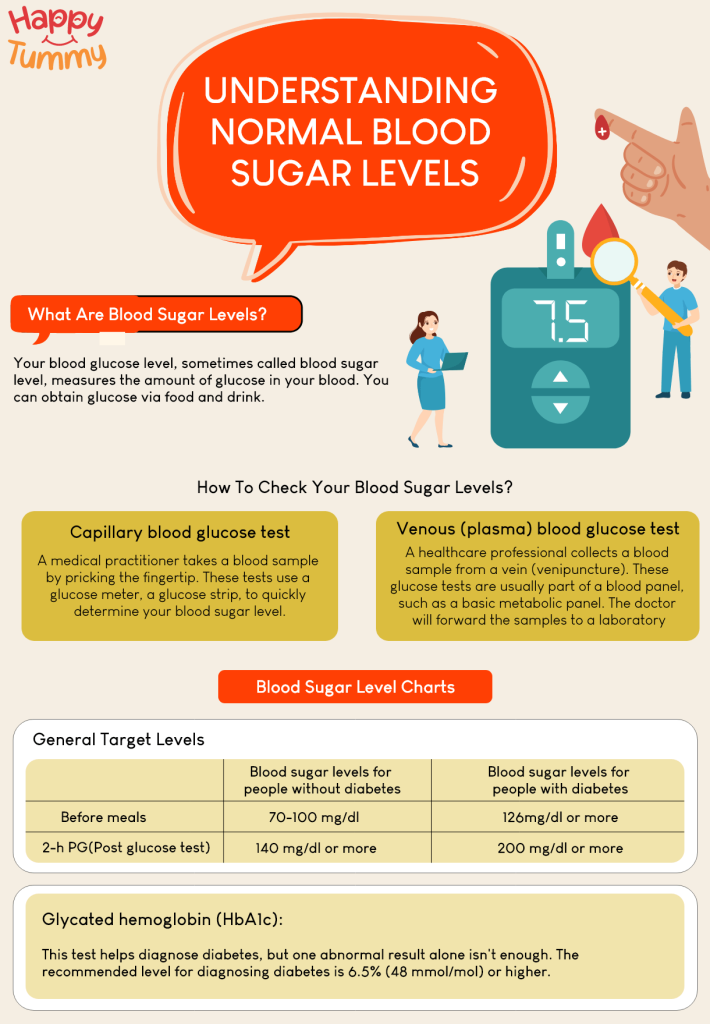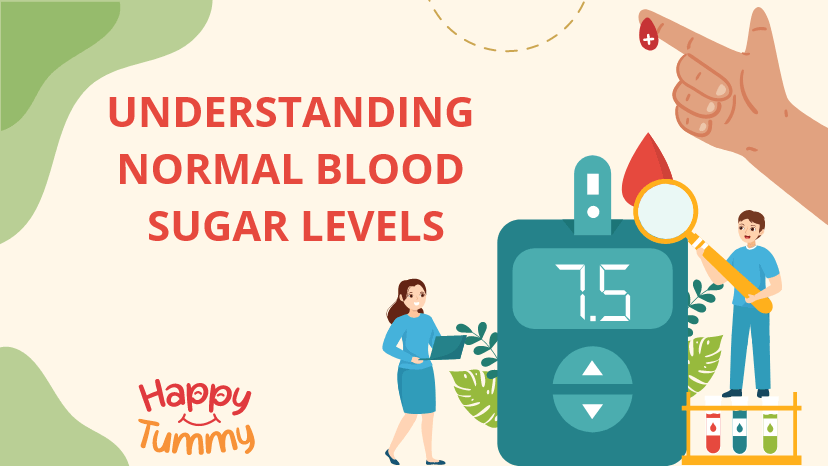Table of Contents
Fitness has become a top priority in everyone’s life. We long for a healthy body, and it is crucial to understand the basics of normal health to prevent any health problems.
However, keeping track of your blood sugar levels is crucial to diabetes management. So, understanding what normal blood sugar levels entail has become imperative for everyone.
Knowing your blood sugar levels may help you manage your diabetes and lower your chance of developing significant problems. Above all, being aware of your blood sugar levels may encourage you to make healthier dietary and lifestyle choices.
But what precisely is deemed “normal” regarding blood sugar levels?
This comprehensive guide will help you understand normal blood sugar levels, different blood glucose tests, and everything else involved in the process.
What Are Blood Sugar Levels?
Your blood glucose level, sometimes called blood sugar level, measures the amount of glucose in your blood. You usually obtain glucose via food and drink.
Blood sugar levels fluctuate throughout the day, and for those who have diabetes, these variations might be pronounced and occur more frequently than for those without it[1].

How to Check Your Blood Sugar Levels?
There are two main types of blood glucose tests:
- Capillary blood glucose test: A medical practitioner takes a blood sample by pricking the fingertip. These tests use a glucose meter, a glucose strip, to quickly determine your blood sugar level [2].
- Venous (plasma) blood glucose test: A healthcare professional collects a blood sample from a vein (venepuncture) [3]. These glucose tests are usually part of a blood panel, such as a basic metabolic panel. The doctor forwards the samples to a laboratory. There, a scientist in a medical laboratory prepares the samples and runs the test using analyzers.
In general, venous blood glucose testing is more precise than capillary blood glucose testing [4].
For screening for diabetes, medical professionals frequently request fasting blood glucose tests.
Fasting blood glucose tests provide a more accurate picture of your baseline blood sugar because eating food impacts blood sugar levels [5].
At-home blood sugar testing
For those with diabetes, there is also the option of at-home blood sugar testing (using a glucometer). To effectively control their diabetes, people with Type 1 diabetes, in particular, need to check their blood sugar levels several times a day.
Another alternative is a continuous glucose monitoring device (CGM) and oral glucose tolerance test (OOGT), readily available in pharmacists’ stores[6].
Glycated hemoglobin (HbA1c)
This test helps diagnose diabetes, but one abnormal result alone isn’t enough. The recommended level for diagnosing diabetes is 6.5% (48 mmol/mol) or higher.
To confirm a diagnosis, doctors should obtain at least one additional HbA1c or blood sugar test result indicating diabetic levels, ensure the best available testing methods, and repeat the test if the patient remains asymptomatic [7].
Also, read our comprehensive article ” Stay Steady: The Top Benefits of Stable Blood Sugar ” article to understand why maintaining sugar levels may benefit you in the long term.[l1]
Blood Sugar Level Charts
The following charts display the general target levels for people with and without diabetes.
Although these numbers are indicative, each person’s specific blood sugar level varies based on age and other variables. A physician will collaborate with individuals to determine their optimal blood sugar levels and support them in maintaining their target ranges.
General Target Levels
Here are the general target blood sugar levels [6]:
| Blood sugar levels for people without diabetes | Blood sugar levels for people with diabetes | |
| Before meals | 70-100 mg/dl | 126mg/dl or more |
| 2-h PG(Post glucose test) | 140 mg/dl or more | 200 mg/dl or more |
If you’re concerned about your sugar consumption or are prone to conditions such as diabetes, talk to our healthcare provider about what you may do. Reach out to our certified nutritionist for a 45-minute consultation and get a customized nutrition plan created just for you.
What Is A Normal Blood Sugar Level?
Reaching a blood sugar or glucose level considered “normal” is a bit of a flawed concept [9]. The term “normal” is frequently used to describe a person’s blood sugar levels in the absence of diabetes [10].
Nonetheless, this terminology is confusing since blood sugar spikes can also occur in healthy individuals, particularly after eating or ingesting simple carbohydrates like pasta or pizza.
There’s a chance that the person’s blood sugar will climb for a short while, even above those “normal” ranges, and their body will naturally begin manufacturing more insulin to offset that growing glucose level [11].
A similar phenomenon may occur during extreme stress or vigorous exercise periods if the body’s normal glucose metabolism cannot swiftly adjust to the new circumstances.
But to avoid confusion in the air, the target levels are set for reference so that going above will lead to welcoming diseases in the body.
In short, a healthy (normal) fasting blood glucose level for someone without diabetes is 70 to 100 mg/dL (3.9 to 5.6 mmol/L) [11].
Values between 50 and 70 mg/dL (2.8 to 3.9 mmol/L) for people without diabetes can be “normal” too [12].
The Reason for Conducting the Test
If you exhibit symptoms of diabetes, your doctor may prescribe this test. The healthcare provider will almost certainly request a fasting blood sugar test. Individuals with diabetes are also observed using the blood glucose test.
You can take the test as well if you have [13]:
- Frequent urination (Polyuria)
- Excessive thirst (Polydipsia)
- Increased hunger (Polyphagia)
- Loss of weight
- Tiredness
- Slow healing of wounds
- Have put on a lot of weight lately
- Hazy vision
- Perplexity or a shift in your typical speech pattern or manner
- Fainting spells
- Seizures (for the first time)
- Coma or unconsciousness
The Bottom Line
Glucose management is an essential part of diabetes management. No magic number exists for “normal” glucose or blood sugar levels. While there are clinical guidelines on target goals for blood sugar levels, it’s important to remember that glucose levels may vary.
However, those with diabetes must manually monitor their blood sugar and may take enough insulin, or glucose-lowering medicine, to keep everything in balance since their bodies are unable to produce or use insulin appropriately.
Continue to track and look for symptoms so that you can avoid any complications.
Frequently Asked Questions
Your venous blood glucose test results should be available in a day or two. The capillary blood glucose testing results are displayed on the glucometer in seconds. Results from HbA1c blood sugar tests can be available within a few days to a week.
It will help you maintain your health and avoid major diabetic issues both now and in the future. They can also be used to assist in managing diabetes and diagnose prediabetes. If you experience any of the following symptoms—increased urination, weight gain, blurred vision, confusion, fainting, seizures, and unconsciousness or coma—your doctor may also prescribe a blood sugar test.
The two methods available for measuring blood sugar levels are the finger-prick test and the electronic blood glucose monitor, often known as the CGM or flash glucose monitor. It is possible to perform this multiple times a day, which will assist you in monitoring your levels. At the same time, you go about your daily activities and determine how much medication to take and what food to consume.
Blood tests are a frequent and crucial component of medical diagnostic and screening procedures. The risk associated with either type of blood test for glucose is relatively low. The blood draw site or finger prick may be slightly sore or bruised, but these effects usually go away fast.
If your doctor has prescribed a fasting blood glucose test, you will need to fast (i.e., consume nothing but water) for eight to ten hours before the test. Usually, Hba1c and fasting blood glucose provide accurate results.
















